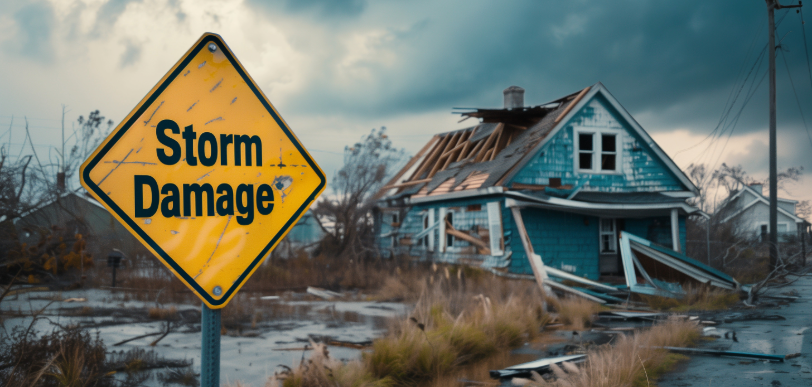Severe weather can cause significant damage to your home, particularly your roof, which is your first line of defense against the elements. Whether you’re preparing for high winds, heavy rains, or hailstorms, a proactive approach can make all the difference in protecting your roof from costly repairs or replacements. In this post, we’ll explore some practical tips on how to prepare for and protect your roof from severe weather, including the best materials to consider.
Getting Your Roof Ready for Different Types of Severe Weather
High Winds
High winds can easily tear off shingles and create weak spots in your roof. One of the simplest ways to prepare is by making sure your shingles are securely fastened. A loose shingle during a windstorm can be the beginning of more extensive roof damage. If you live in a hurricane or tornado-prone area, consider investing in hurricane straps for added security.
Best Practice: Keep an eye on nearby trees—overgrown branches can snap during windstorms and cause significant damage to your roof. Trimming those back regularly can save you a lot of headache in the long run.
Hailstorms
Hailstorms can be brutal on roofs, particularly if your shingles aren’t impact-resistant. The best way to prepare is by choosing roofing materials specifically designed to withstand hail. If you live in an area where hailstorms are common, consider installing Class 4 impact-resistant shingles, which are engineered to handle these kinds of weather events.
Best Practice: After any hailstorm, even if the damage isn’t immediately visible from the ground, it’s important to get a professional inspection to check for hidden issues.
Heavy Rain
When it comes to rain, your roof’s drainage system is just as important as the roofing material itself. Clogged gutters or downspouts can lead to water pooling on your roof, which can cause leaks and long-term structural damage.
Best Practice: Make sure to regularly clean your gutters and downspouts. Also, inspect the flashing around chimneys, vents, and skylights to ensure that everything is sealed and watertight.
Snow and Ice
Snow and ice can add an incredible amount of weight to your roof, and the freeze-thaw cycle can create ice dams. These ice dams trap water, which can then leak into your home. Preparing for snow-heavy seasons involves more than just snow removal—it's about preventing ice dams from forming in the first place.
Best Practice: Improve attic insulation and ventilation to prevent ice dams. Also, consider installing snow guards or heat cables in areas prone to ice build-up.
Best Roofing Materials for Severe Weather
Impact-Resistant Shingles:
If you live in an area prone to hailstorms or high winds, impact-resistant shingles are an excellent investment. These shingles are designed to withstand impact from debris and hail, providing added protection to your home.
Metal Roofing:
Known for its durability, metal roofing can resist damage from severe weather like high winds, hail, and snow. It’s also fire-resistant, which is an added benefit in areas prone to wildfires.
Architectural Shingles:
These shingles are thicker and more durable than traditional 3-tab shingles. They provide excellent wind and water resistance, making them a good option for areas with mixed weather conditions.
Clay and Concrete Tiles:
If you’re in an area that faces high winds or extreme heat, clay or concrete tiles are worth considering. They’re highly durable and also provide excellent fire resistance, making them ideal for homes in wildfire-prone areas.

Best Practices for Roof Maintenance and Storm Preparedness
Routine Inspections:
Whether you do it yourself or hire a professional, regular roof inspections can help you spot damage before it turns into a bigger issue. Look for missing shingles, cracks in the flashing, and any other visible signs of wear and tear.
Gutter Maintenance:
Clogged gutters can lead to water pooling on your roof, increasing the risk of leaks. Regularly clean your gutters and downspouts to ensure proper water flow during rainstorms.
Act Before the Storm:
If severe weather is predicted, secure loose items in your yard, such as patio furniture, to prevent them from becoming airborne and damaging your roof. Double-check that any minor roof repairs are completed before a storm hits.
Emergency Supplies:
Having emergency supplies like tarps and roofing nails on hand can help you make quick repairs in the event of storm damage, minimizing further harm to your home.
Filing a Home Insurance Claim for Roof Damage
If your roof sustains damage from severe weather, filing a home insurance claim can help cover repair or replacement costs. To ensure your claim goes smoothly, document the damage thoroughly with photos and contact your insurance provider as soon as possible. It's important to understand the steps involved in filing a claim, which includes an inspection by an adjuster, and how to present your case clearly.
For more details on the process, check out this comprehensive guide on How to File a Home Insurance Claim for Roof Damage.
Conclusion
By taking the right precautions, you can extend the life of your roof and minimize the risk of damage from severe weather. Whether it’s high winds, hail, heavy rain, or snow, maintaining your roof and using the right materials can keep your home safe from the elements. Regular inspections, preventive maintenance, and choosing durable, weather-resistant materials will help ensure that your roof remains strong and functional for years to come.
It's also important to know when your roof might be past its prime. Learn about the Signs You Need a New Roof to ensure your roof is ready to handle severe weather without any surprises.
By following these tips, you’re not only protecting your roof but also your home and everything inside it. Remember, an ounce of prevention is worth a pound of cure—especially when it comes to severe weather!
written by RoofScope published on 10. 24. 2024

